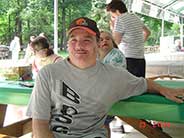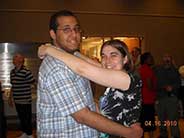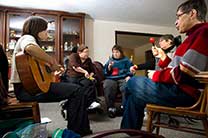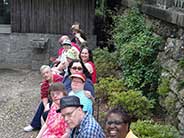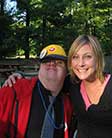Though your family directed home isn’t a business in a traditional sense, developing a formal written plan detailing legal and business decisions is critical.
Why Have a Formal Plan?
A formal written plan may be needed for some sources of funding. In the past, families were required to submit a proposal to the county board. This may or may not be required now because of changes in the waiting list rules. Check with your local county board to see if a plan or proposal is required.
Benefits of a Formal Plan
- Ensures that everyone has the same goals and agrees on the process
- Gives the group a path to follow
- Helps to get funding
- Communicates the group’s philosophy and goals to support staff or other service providers
There is no specific format for the plan or a form to complete; the exact format is up to you. The guidelines in this manual are taken from sample plans.
If you have corporate or association bylaws, or a proposal for funding, these can often serve as the written plan.
Your group should work on its own plan first, before referring to others’ plans for ideas. The decisions and information contained in a plan are vital to the project’s success, and it is important that the team come to consensus on these issues. Using someone else’s plan as a model can lead to adopting another group’s decisions, leading to conflicts or regrets later in the process.
The plan should show that the following has been considered:
- the health and safety of the residents
- the wishes and desires of the housemates
- the compatibility of the housemates
- common goals within the group
- consensus on such issues as:
- an organizational structure identifying individual roles and responsibilities
- a process for making decisions and resolving conflicts
- detailed and realistic financial plans, including all potential costs
- the contributions that each member will make, including finances, time, personal expertise, and organizational functions
- individualized planning for each resident that addresses personal needs
- long-term stability and flexibility for each resident
Understand that this is another time-consuming part of the process, but doing it conscientiously and early will expedite the home creation project.
Putting the Plan Together
Preparing this plan will entail many drafts and consultation among the families. Advisors such as circle-of-support members, attorneys, friends, and professionals with whom the families have worked are helpful resources to finalizing the plan.
The components of the plan include a cover letter and the body of the plan.
Cover Letter
The cover letter serves as the introduction a potential funding source or county board. It must reflect your group’s credibility. Cover letters should be brief, because the proposal as a whole will cover the details.
Cover letters should:
- Be brief (details are covered in the body of the plan)
- Be addressed to the Manager of Community Supports (or a similar position) at the county board or organization
- Indicate your intent to develop a home for family members with intellectual disabilities
- State the group’s overall objectives
- Request financial support to pay for support services
- Indicate a willingness to provide additional information
- Identify a contact person from your group
- Include a list of the individuals and family members, addresses, phone numbers, and e-Mail addresses
If you need to send your plan to more than one organization for funding or other requests, be sure to customize the cover letter’s content to match who you’re sending it to.
Plan Body
This is the majority of the written plan and is intended to convince readers that the group needs and deserves support. Your audience will expect to see evidence that your group has thought through all of the details before requesting support.
The plan should include the following components:
Philosophical Perspective: This section discusses quality-of-life issues for individuals with disabilities, including independence, self-determination, individual rights, health and safety, and community participation.
Common Goals: A list or explanation of the group’s goals which can then serve as a mission statement as well.
Group Structure: Describe your group’s organization, making sure to answer the following questions:
- Is the agreement a binding legal document?
- Who is included in the group? What constitutes a membership?
- How will the group be structured? Will it have officers?
- How will decisions be made?
- Who will serve as a liaison to outside agencies?
- Who can join? What happens if someone leaves?
- What is the group’s relationship with other organizations, such as the county board or other service providers?
Then, any written agreements can appear as an appendix.
Program Feasibility: This should include as many details as possible about how the home will function. For example:
- profiles on each prospective resident in the home
- an example of plans for daily life within the home and activities outside the home (employment or community participation)
- a proposed staffing pattern, including how much assistance is needed and at what times
Home Feasibility: This covers the nuts-and-bolts of the home purchase, including:
- details about the home’s style, such as “ a single family, one story, wheelchair-accessible property”;
- the location and surrounding amenities, such as access to public transit or proximity to parents;
- a statement on who will own the home;
- an explanation of who will manage the home; and
- a description of how purchases will be made for the home, including furnishings and appliances.
Financial Feasibility: A detailed explanation will show that the group has thoroughly thought through both the purchase of the home and the expenses of running it. This section should include:
- three budgets (for the home’s purchase; support services; and daily living expenses)
- an explanation of how viability has been ensured
Policies: This section should include all policies developed for running the home, such as:
- consortium member agreement
- rights of individuals with intellectual disabilities
- personnel policies, if families are managing support services themselves
- policy on termination of members
- policy on conflict resolution
Specific Questions the Plan Should Answer
Use these questions as a checklist as you and others work on drafts, and during a final draft review.
- What are the group’s philosophy and goals?
- How will the group be established as a legal entity (trust, association, corporation, partnership)?
- How often will the group meet?
- What is the minimum number of meetings?
- Who are the members of the group?
- What constitutes a membership for voting purposes?
- What is the financial responsibility of each member?
- Who will serve as liaison with other agencies? Will this person continue as liaison indefinitely? If not, how will new liaisons be chosen?
- If an original member of the group is no longer able to serve, who will replace that person? (This may be an individual decision for each family.)
- How will decisions be made (by a majority or quorum, or unanimously)?
- What decisions will require a vote?
- Will some decisions require a majority vote vs. a unanimous vote?
- How will the group members ensure that the desires and preferences of the residents of the home will be considered in decision-making?
- How will roles and responsibilities be assigned (president, secretary, treasurer)?
- What will happen if a group member does not fulfill responsibilities in an acceptable manner?
- What if a member of the group wants to leave or the resident wants to move out?
- If a member leaves, how will shared expenses be covered until a new member is chosen?
- How will new members be found and chosen?
- Do group members have to give a prescribed notice (a month, two months?) for withdrawal from the group?
- Under what circumstances can the group ask a member or resident to leave? How would the group make the decision to ask a member or resident to leave?
- How much notice would be given to a person asked to leave so that he or she could make other arrangements?
- How will disputes be handled between group members, between residents, and with the provider agency or staff?
- How will the provider be chosen?
- What is the expected level of support services? *
- What is the anticipated cost for support services? *
- Are there any additional or different staffing needs for setting up the home or helping residents transition to the new home? *
- What (if any) responsibilities will families maintain for daily care and support, such as medical appointments, financial accounts, vacation planning?
- Who will manage the home in the future?
* In cases where the county board will fund support services, the board will evaluate individual needs and determine budgets. The families can use the plan to suggest what they feel will be needed.



